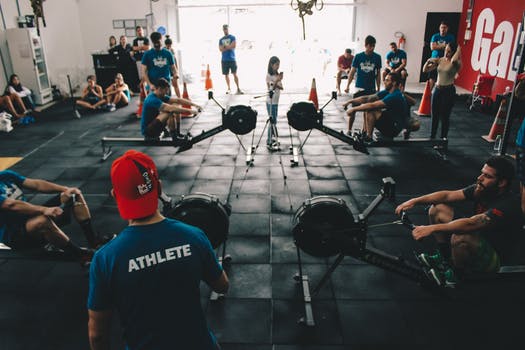Hi guys. Physical Education has become an absolute requirement these days. We all want to stay healthy and fit. Physical education is not only limited to sports, but it includes other activities too which are done for fitness. In this article, I will brief you on a crucial aspect of physical education, i.e., “Principles of Training”.
Training is essential when it comes to improving our skills in any Sport or activity. Training can be both Aerobic and Anaerobic. I will be describing both below.
Aerobic Training

Here, I am talking about all the aerobic exercises. The word aerobic relates to a good oxygen supply. Aerobic exercise is the one which is steady and not too fast. The heart can supply enough oxygen to the muscles of your body. Aerobic training improves your cardiovascular fitness.
Anaerobic Training

It includes anaerobic exercises. The word Anaerobic relates to lack of oxygen. Anaerobic exercise is the one which is performed in short and fast bursts where the heart is not able to supply enough oxygen to your muscles. Anaerobic training improves the ability of your muscles to work even in lesser oxygen supply when lactic acid is produced.
Methods of Training

There are specific training methods which can be used to improve the fitness factors. Following are the various methods of training:
- Circuit Training- It involves doing a series of exercises in a specific order called a circuit. Each activity has a “station,” where that particular activity is performed. The station can be designed to improve coordination, speed, balance and muscular endurance.
- Cross Training- It includes using another various activities or sport to improve your fitness. It happens when an athlete gets trained in a different environment. You can take the example of a basketball player who uses power training for this sport. It helps the player to get fit for the long jumps.
- Continuous training- This type of training involves working for a set period without any rest in between. It improves your cardiovascular fitness.
- Fartlek Training- It is also known as ‘speed play training.’ It involves changing your speed and also the type of terrain on which you walk, run, ski or cycle. It improves both aerobic and anaerobic fitness.
- Weight Training- In this intensive training, weights are used to provide resistance to the muscles of your body. It helps to improve your muscular endurance (high reps, low weight, and many sets), muscular strength (low reps, high weight) and power (medium weight with quickly performed reps).
- Interval Training- As the name itself states this type of training involves altering of hard exercise and rest. This training improves your muscular endurance and speed.
- Altitude Training- This training is a type of aerobic training which is performed above sea level, where the oxygen level is low. It is used to quickly grow aerobic fitness.
What are the Principles of Training?
To get the best out of your training, you need to follow the set principles of training. The best training programs are based on set principles. The principles are Specificity, Progression, Overload, Reversibility, Rest and Tedium. These principles combine up to one acronym, i.e., SPORRT.
A training program should be designed according to an individual’s need. A plan which is made according to the principles of training helps to improve the game ability, performance, skill, and physical fitness.
To remember the key things while making a program for an individual sport or activity, you can use the acronym “FITT”. FITT stands for Frequency, Intensity, Time and Type. A successful training program will meet the needs of an individual based on gender, age, fitness level and the sport for which he/she wants to get trained. So, let’s move on to the principles of training.
Key Principles of Training

Training is the reason behind an athlete’s outstanding performance. It is crucial to follow the principles of training if you need to complete the training successfully. Following are those key principles of training:
Specificity
For improving the range of movement of specific joint action, you need to perform exercises which involve that joint action. It is possible that you might have joints which move properly and then there are those joints which have less mobility. Working only on one specific area of the body will not improve the working of other areas. You need to work on the overall mobility of your body parts and joints.
Each athlete will require different training types according to the type of sport which they have to play. Specificity is a crucial principle in strength training. According to this principle, the exercise should be specific to the type strength which is required for it. It automatically connects with the sport/event related.
The speed is also one of the most important aspects of the training. The speed should also be specified for individual sport or event. It means that what kind of speed is required in the workout during your training.
Progression
This is another very crucial principle of training. The principle of progression states that you should start your training slowly and then later, increase the amount of exercise and keep overloading. This process should be gradual. The key point here is, not to progress too quickly, as you might end up hurting yourself in the form of an injury.
Overload
When you perform a mobility exercise, you should stretch till the end of the range of movement. The end of the range of movement is called as the active end position. Improvements in mobility can only be achieved when you try to move beyond the active end position.
Your muscles will only strengthen when you force to operate them beyond its set intensity. But, be careful and don’t hurt yourself. Practice is what will make you perfect. The load should be increased but slowly-slowly. This is called overloading. You have to come out of the comfort zone of your body.
Reversibility
With the regular use of mobility exercises, the ranges of movement are achieved and maintained. You can’t cease mobility training; otherwise, your body movements will decline over time. Any adaption which takes place while you are training will get reversed if you stop training. Any break in the training will lead you towards losing your fitness.
Rest or Recovery
This is very important. You also need to give your body a time to rest and recover. This rest can come in between the sets or on the complete rest days. Your body needs rest too. It needs time to recover the energy which has been put up into the workout. So, a good rest is also important.
Tedium
This principle states that you should opt for a training method which includes a variety of workouts in it. It will relieve tedium and also boredom to come in between your training. Always remember, when you are planning a program, apply the FITT principle too. FITT: Frequency, Intensity, Time, Type.
Conclusion
So, guys, I hope now you the principles of training. These were not only for athletes but, also for those of you who want to be a part of some training program. If you liked this information, then do let me know through your comments below. For any query, or for any online assignment help, you can email us on the id given on our website. Thank you for reading. 🙂
